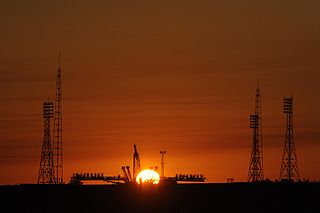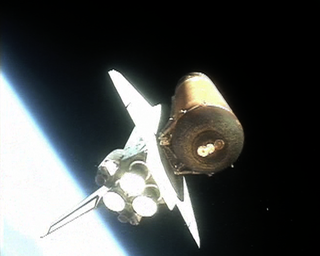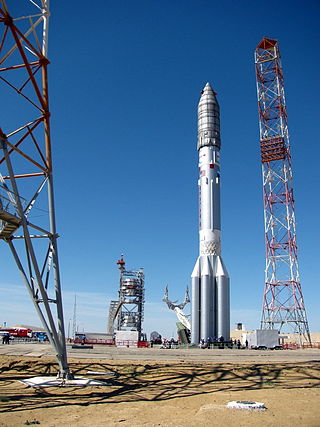
A single-stage-to-orbit (SSTO) vehicle reaches orbit from the surface of a body using only propellants and fluids and without expending tanks, engines, or other major hardware. The term usually, but not exclusively, refers to reusable vehicles. To date, no Earth-launched SSTO launch vehicles have ever been flown; orbital launches from Earth have been performed by either fully or partially expendable multi-stage rockets.

Energia was a 1980s super-heavy lift launch vehicle. It was designed by NPO Energia of the Soviet Union as part of the Buran program for a variety of payloads including the Buran spacecraft. Control system main developer enterprise was the Khartron NPO "Electropribor". The Energia used four strap-on boosters each powered by a four-chamber RD-170 engine burning kerosene/LOX, and a central core stage with four single-chamber RD-0120 (11D122) engines fueled by liquid hydrogen/LOX.

Proton is an expendable launch system used for both commercial and Russian government space launches. The first Proton rocket was launched in 1965. Modern versions of the launch system are still in use as of 2023, making it one of the most successful heavy boosters in the history of spaceflight. The components of all Protons are manufactured in the Khrunichev State Research and Production Space Center factory in Moscow and Chemical Automatics Design Bureau in Voronezh, then transported to the Baikonur Cosmodrome, where they are assembled at Site 91 to form the launch vehicle. Following payload integration, the rocket is then brought to the launch pad horizontally by rail, and raised into vertical position for launch.

Soyuz is a family of expendable Russian and Soviet carrier rockets developed by OKB-1 and manufactured by Progress Rocket Space Centre in Samara, Russia. With over 1,900 flights since its debut in 1966, the Soyuz is the rocket with the most launches in the history of spaceflight.

A spaceport or cosmodrome is a site for launching or receiving spacecraft, by analogy to a seaport for ships or an airport for aircraft. The word spaceport, and even more so cosmodrome, has traditionally been used for sites capable of launching spacecraft into orbit around Earth or on interplanetary trajectories. However, rocket launch sites for purely sub-orbital flights are sometimes called spaceports, as in recent years new and proposed sites for suborbital human flights have been frequently referred to or named "spaceports". Space stations and proposed future bases on the Moon are sometimes called spaceports, in particular if intended as a base for further journeys.

A reusable launch vehicle has parts that can be recovered and reflown, while carrying payloads from the surface to outer space. Rocket stages are the most common launch vehicle parts aimed for reuse. Smaller parts such as rocket engines and boosters can also be reused, though reusable spacecraft may be launched on top of an expendable launch vehicle. Reusable launch vehicles do not need to make these parts for each launch, therefore reducing its launch cost significantly. However, these benefits are diminished by the cost of recovery and refurbishment.

A spaceplane is a vehicle that can fly and glide like an aircraft in Earth's atmosphere and maneuver like a spacecraft in outer space. To do so, spaceplanes must incorporate features of both aircraft and spacecraft. Orbital spaceplanes tend to be more similar to conventional spacecraft, while sub-orbital spaceplanes tend to be more similar to fixed-wing aircraft. All spaceplanes to date have been rocket-powered for takeoff and climb, but have then landed as unpowered gliders.

An orbital spaceflight is a spaceflight in which a spacecraft is placed on a trajectory where it could remain in space for at least one orbit. To do this around the Earth, it must be on a free trajectory which has an altitude at perigee around 80 kilometers (50 mi); this is the boundary of space as defined by NASA, the US Air Force and the FAA. To remain in orbit at this altitude requires an orbital speed of ~7.8 km/s. Orbital speed is slower for higher orbits, but attaining them requires greater delta-v. The Fédération Aéronautique Internationale has established the Kármán line at an altitude of 100 km (62 mi) as a working definition for the boundary between aeronautics and astronautics. This is used because at an altitude of about 100 km (62 mi), as Theodore von Kármán calculated, a vehicle would have to travel faster than orbital velocity to derive sufficient aerodynamic lift from the atmosphere to support itself.
The Polyus spacecraft, also known as Polus, Skif-DM, GRAU index 17F19DM, was a prototype Soviet orbital weapons platform designed to destroy Strategic Defense Initiative satellites with a megawatt carbon-dioxide laser. It had a Functional Cargo Block derived from a TKS spacecraft to control its orbit and it could launch test targets to demonstrate the fire control system.

The Angara rocket family is a family of launch vehicles being developed by the Moscow-based Khrunichev State Research and Production Space Center. The launch vehicles are to put between 3,800 kg (8,400 lb) and 24,500 kg (54,000 lb) into low Earth orbit and are intended, along with Soyuz-2 variants, to replace several existing launch vehicles.

Geosynchronous Satellite Launch Vehicle (GSLV) is a class of expendable launch systems operated by the Indian Space Research Organisation (ISRO). GSLV has been used in fifteen launches since 2001.

A launch vehicle is typically a rocket-powered vehicle designed to carry a payload from Earth's surface or lower atmosphere to outer space. The most common form is the ballistic missile-shaped multistage rocket, but the term is more general and also encompasses vehicles like the Space Shuttle. Most launch vehicles operate from a launch pad, supported by a launch control center and systems such as vehicle assembly and fueling. Launch vehicles are engineered with advanced aerodynamics and technologies, which contribute to high operating costs.

Rokot, also transliterated Rockot, was a Soviet Union space launch vehicle that was capable of launching a payload of 1,950 kilograms (4,300 lb) into a 200-kilometre (120 mi) Earth orbit with 63° inclination. It was based on the UR-100N intercontinental ballistic missile (ICBM), supplied and operated by Khrunichev State Research and Production Space Center. The first launches started in the 1990s from Baikonur Cosmodrome out of a silo. Later commercial launches commenced from Plesetsk Cosmodrome using a launch ramp specially rebuilt from one for the Kosmos-3M launch vehicle. The cost of the launcher itself was about US$15 million in 1999; The contract with European Space Agency (ESA) for launching Swarm in September 2013 was worth €27.1 million.
Fregat (Russian: Фрегат, frigate) is an upper stage developed by NPO Lavochkin in the 1990s, which is used in some Soyuz and Zenit launch vehicles, but is universal and can be used as a part of a medium and heavy class launch vehicles. Fregat became operational in February 2000. Its liquid propellant engine uses UDMH and N2O4. Fregat's success rate is 97.8% (with 2 failures in 93 launches), which makes it one of the most reliable upper stages in the world. Fregat has successfully delivered more than 300 payloads into different orbits. It remains the only upper stage in the world that can place its payload into 3 or more different orbits in a single launch.
The Briz-K, Briz-KM and Briz-M are Russian liquid-propellant rocket orbit insertion upper stages manufactured by Khrunichev State Research and Production Space Center and used on the Proton-M and Angara A5. The upper stages were also used on Rokot, one of Russia's smaller launchers, before its retirement in 2019.

The Proton-M, (Протон-М) GRAU index 8K82M or 8K82KM, is an expendable Russian heavy-lift launch vehicle derived from the Soviet-developed Proton. It is built by Khrunichev, and launched from sites 81 and 200 at the Baikonur Cosmodrome in Kazakhstan. Commercial launches are marketed by International Launch Services (ILS), and generally use Site 200/39. The first Proton-M launch occurred on 7 April 2001.
Intelsat 5 was a satellite providing television and communication services for Intelsat, which it was commissioned by in 2006.

Soyuz at the Guiana Space Centre was a European Space Agency (ESA) programme for operating Soyuz-ST launch vehicles from Centre Spatial Guyanais (CSG), providing medium-size launch capability for Arianespace to complement the light Vega and heavy-lift Ariane 5. The Soyuz vehicle was supplied by the Roscosmos with TsSKB-Progress and NPO Lavochkin, while additional components were supplied by Airbus, Thales Group and RUAG. Autor LV (ICBM) = NPO "Energia", Kaliningrad.
A medium-lift launch vehicle (MLV) is a rocket launch vehicle that is capable of lifting between 2,000 to 20,000 kg by NASA classification or between 5,000 to 20,000 kilograms by Russian classification of payload into low Earth orbit (LEO). An MLV is between small-lift launch vehicles and heavy-lift launch vehicles.

A super heavy-lift launch vehicle is a rocket that can lift to low Earth orbit a "super heavy payload", which is defined as more than 50 metric tons (110,000 lb) by the United States and as more than 100 metric tons (220,000 lb) by Russia. It is the most capable launch vehicle classification by mass to orbit, exceeding that of the heavy-lift launch vehicle classification.















